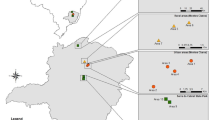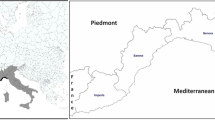Abstract
Like other organisms, ants require suitable microclimatic conditions for their development. Thus, ant species inhabiting colder climates build nest mounds that rise above the soil surface, presumably to obtain heating from solar radiation. Although some ant species construct mounds of organic materials, which generate substantial heat due to microbial metabolism, Lasius flavus mounds consists mostly of soil, not organic material. The use of artificial shading in the current study demonstrated that L. flavus depends on direct solar radiation to regulate the temperature in its mound-like nests. Temperatures were much lower in shaded mounds than in unshaded mounds and were likely low enough in shaded mounds to reduce ant development and reproduction. In areas where L. flavus and similar ants are undesirable, they might be managed by shading.


Similar content being viewed by others
References
Abril S, Oliveras J, Gómez C (2010) Effect of temperature on the development and survival of the Argentine ant, Linepithema humile. J Insect Sci 10:97. doi:10.1673/031.010.9701
Andersen AN (1995) A classification of Australian ant communities, based on functional groups which parallel plant life-forms in relation to stress and disturbance. J Biogeogr 22:15–29. doi:10.2307/2846070
Anderson KE, Munger JC (2003) Effect of temperature on brood relocation in Pogonomyrmex salinus (Hymenoptera: Formicidae). West N Am Naturalist 63:122–128
Banschbach VS, Levit N, Herbers JM (1997) Nest temperatures and thermal preferences of a forest ant species: is seasonal polydomy a thermoregulatory mechanism? Insect Soc 44:109–122. doi:10.1007/s000400050034
Bezděčka P, Bezděčková K (2011) Ants in the collections of Czech, Moravian and Silesian museums. Muzeum Vysočiny, Jihlava
Boer P, Vierbergen B (2008) Exotic ants in the Netherlands (Hymenoptera: Formicidae). Entomol Ber 68:121–129
Brandt CJ (1980) The thermal diffusivity of the organic material of a mound of Formica polyctena forest in relation to the thermoregulation of the brood (Hymenoptera, Formicidae). Neth J Zool 30:326–344
Brian MV, Brian AD (1951) Insolation and ant population in the west of Scotland. Trans R ent Soc Lond 102:303–330. doi:10.1111/j.1365-2311.1951.tb00751.x
Coenen-Staß D, Schaarschmidt B, Lamprecht I (1980) Temperature distribution and calorimetric determination of heat production in the nest of the wood ant, Formica polyctena (Hymenoptera, Formicidae). Ecology 61:238–244. doi:10.2307/1935180
Culek M (1995) Biogeografické členění České republiky. Enigma, Praha
Czechowski W, Radchenko A, Czechowska W (2002) The ants (Hymenoptera, Formicidae) of Poland. Museum and Institute of Zoology PAS, Warszawa
Dahms H, Lenoir L, Lindborg R, Wolters V, Dauber J (2010) Restoration of seminatural grasslands: what is the impact on ants? Restor Ecol 18:330–337. doi:10.1111/j.1526-100X.2008.00458.x
Dean WRJ, Turner JS (1991) Ants nesting under stones in the semi-arid Karoo, South Africa: predator avoidance or temperature benefits. J Arid Environ 21:59–69
Dostál P, Březnová M, Kozlíčková V et al (2005) Ant-induced soil modification and its effect on plant below-ground biomass. Pedobiologia 49:127–137. doi:10.1016/j.pedobi.2004.09.004
Fernández-Escudero I, Tinaut A, Ruano F (1993) Rock selection for nesting in Proformica Longiseta Collingwood, 1978 (Hymenoptera, Formicidae) in a Mediterranean high mountain. Int J Biometeorol 37:83–88. doi:10.1007/BF01214386
Frouz J (1996) The role of nest moisture in thermoregulation of ant (Formica polyctena, Hymenoptera, Formicidae) nests. Biologia 51:541–547
Frouz J (2000) The effect of nest moisture on daily temperature regime in the nests of Formica polyctena wood ants. Insect Soc 47:229–235. doi:10.1007/PL00001708
Higgins RJ, Lindgren BS (2012) The effect of manipulated shading on the colony abundance of two species of ants, Formica aserva and Leptothorax muscorum, in dead wood. Entomol Exp Appl 143:292–300
Holec M, Frouz J (2006) The effect of two ant species Lasius niger and Lasius flavus on soil properties in two contrasting habitats. Eur J Soil Biol 42:213–S217. doi:10.1016/j.ejsobi.2006.07.033
Hölldobler B, Wilson EO (1990) The ants. Belknap/Harvard University Press, Cambridge
Kadochová Š, Frouz J (2014) Thermoregulation strategies in ants in comparison to other social insects, with a focus on red wood ants (Formica rufa group). F1000Research 2:280. doi: 10.12688/f1000research.2-280.v1
Kilpeläinen J, Punttila P, Finér L, Niemelä P, Domisch T, Jurgensen MF, Neuvonen S, Ohashi M, Risch AC, Sundström L (2008) Distribution of ant species and mounds (Formica) in different-aged managed spruce stands in eastern Finland. J Appl Entomol 132:315–325. doi:10.1111/j.1439-0418.2007.01244.x
Kipyatkov VE, Lopatina EB (2015) Comparative study of thermal reaction norms for development in ants. Entomol Sci 18:174–192. doi:10.1111/ens.12098
Kipyatkov VE, Lopatina EB, Imamgaliev AA, Shirokova LA (2004) Effect of temperature on rearing of the first brood by the founder females of the ant Lasius niger (Hymenoptera, Formicidae): latitude-dependent variability of the response norm. J Evol Biochem Physiol 40:134–141. doi:10.1023/B:JOEY.0000033808.45455.75
Lenoir L, Persson T, Bengtsson J (2001) Wood ant nests as potential hot spots for carbon and nitrogen mineralisation. Biol Fertil Soils 34:235–240. doi:10.1007/s003740100405
Lopéz R, Held DW, Potter DA (2000) Management of a mound-building ant, Lasius neoniger Emery, on golf putting greens and tees using delayed-action baits or fipronil. Crop Sci 40:511–517
Mikheyev AS, Tschinkel WR (2004) Nest architecture of the ant Formica pallidefulva: structure, costs and rules of excavation. Insect Soc 51:30–36. doi:10.1007/s00040-003-0703-3
Odum EP, Pontin AJ (1961) Population density of the underground ant, Lasius flavus, as determined by tagging with P32. Ecology 42:186–188
Penick CA, Tschinkel WR (2008) Thermoregulatory brood transport in the fire ant, Solenopsis invicta. Insect Soc 55:176–182. doi:10.1007/s00040-008-0987-4
Rosengren R, Fortelius W, Lindström K et al (1987) Phenology and causation of nest heating and thermoregulation in red wood ants of the Formica rufa group studied in coniferous forest habitats in southern Finland. Ann Zool Fennici 24:147–155
Smallwood J (1982) The effect of shade and competition on emigration rate in the ant Aphaenogaster rudis. Ecology 63:124–134. doi:10.2307/1937038
Smallwood J, Culver DC (1979) Colony movements of some north American ants. J Anim Ecol 48:373–382
Thomas ML (2002) Nest site selection and longevity in the ponerine ant Rhytidoponera metallica (Hymenoptera, Formicidae). Insect Soc 49:147–152. doi:10.1007/s00040-002-8294-y
Tschinkel WR (2006) The fire ants. Belknap Press of Harvard University Press, Cambridge
Vogt JT, Wallet B, Freeland TB (2008) Imported fire ant (Hymenoptera: Formicidae) mound shape characteristics along a north-south gradient. Environ Entomol 37:198–205. doi:10.1603/0046-225X
Wilson EO (1971) The insect societies. Belknap Press of Harvard Uviversity Press, Cambridge, Massachusets
Acknowledgements
This work was supported by the project of the Ministry of Agriculture of the Czech Republic—Resolution RO0116 (reference number 10462/2016-MZE-17011). The authors thank Dr. Bruce Jaffee for linguistic and editorial improvements.
Author information
Authors and Affiliations
Corresponding author
Rights and permissions
About this article
Cite this article
Véle, A., Holuša, J. Microclimatic conditions of Lasius flavus ant mounds. Int J Biometeorol 61, 957–961 (2017). https://doi.org/10.1007/s00484-016-1275-z
Received:
Revised:
Accepted:
Published:
Issue Date:
DOI: https://doi.org/10.1007/s00484-016-1275-z




